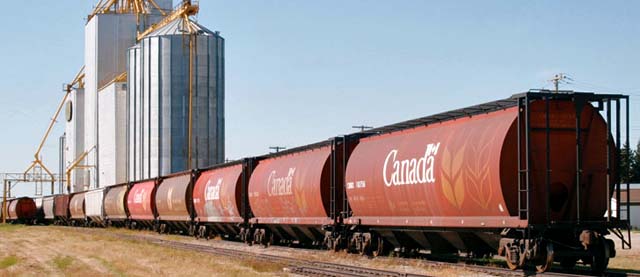|
A string of Trudeau hoppers - Date unknown Anonymous Photographer.
20 August 2015
Grain Sector Needs to Discuss
Hopper Car Replacement
Canada - Officials at Canadian Pacific Railway say railway companies, the grain industry, and the federal government should start
talking now about how to replace the aging fleet of federally owned hopper cars.
The company is also suggesting that the Maximum Revenue Entitlement (MRE), also known as the railway revenue cap, could play a role in paying for new
cars.
"The car piece is an elephant in the room," said John Brooks, CP's vice-president in charge of grain.
"That's certainly one issue that I think requires some collaboration between government, between shippers, and certainly between railways to figure out
how we're going to make that next step."
Canada's grain hopper cars are rolling toward the end of their lives.
The federal government owns approximately 8,400 of them.
By some estimates, that represents 25 to 30 percent of the grain cars now in use in Canada.
According to a recent report from Transport Canada, the federal hopper car fleet will likely shrink to half its current size in about 10 years.
In 20 years, it will be almost eliminated.
Nearly 3,500 cars are scheduled to be scrapped for salvage value in 2026 or 2027 and most of the remainder will be retired between 2032 and 2035.
In an 11 Aug 2015 interview, Brooks said it's time for stakeholders in the grain supply chain to talk about fleet renewal.
At an estimated cost of $100,000 per car, replacing the entire federal fleet could cost nearly $1 billion.
In its submission to the Canada Transportation Act (CTA) review panel, CP suggested that federal hopper cars could be replaced with shorter cars that haul more
grain but take up less rail space.
The result would be unit trains that have more cars and increased hauling capacity.
Government of Canada hopper cars are 59 feet long and have a load limit of 93 tonnes per car.
Modern replacement cars are 53 feet long and have a load limit of 101 tonnes.
"It's certainly an aging fleet and I think it's probably missing out on the technology improvements that are available in terms of capacity gains that
can be had," Brooks said.
In its CTA submission, CP suggested regulatory policies that limit the amount of revenue that can be collected from moving grain inhibit investment in Canada's
rail network.
In particular, CP's submission identified the MRE as a policy that restricts investments in network capacity.
"The removal of the MRE would allow for increased investment, capacity, and overall competitiveness in the supply chain," CP wrote.
"One of the most significant opportunities for investment, but one which the MRE inhibits, is the replacement of Government of Canada hopper
cars."
The MRE was introduced in 2000.
It limits the amount of revenue a railway can generate from moving a tonne of western Canadian grain along a federally regulated railway corridor.
If a railway exceeds the MRE in any year, a penalty is assessed and the excess revenue collected is redirected to the Western Grains Research Foundation to
support research in agriculture.
Brian Cross.
http://www·okthepk·ca/  |



